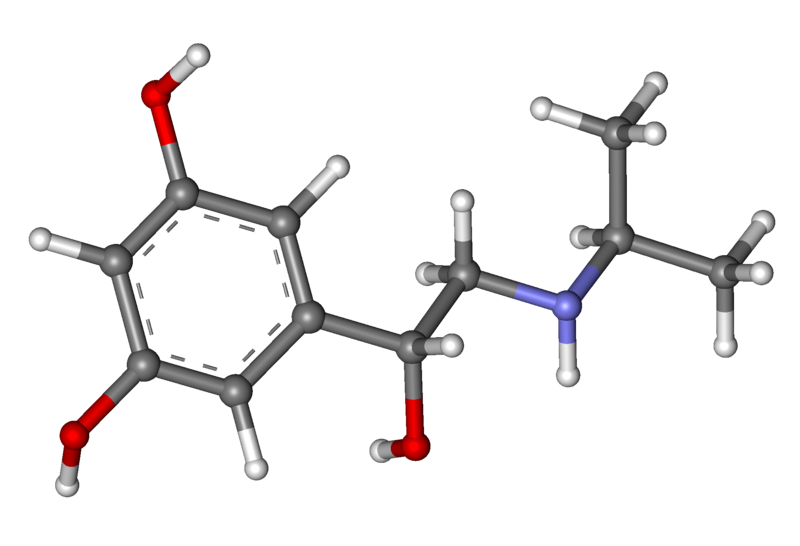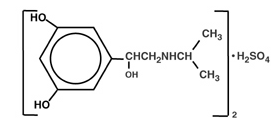Metaproterenol
Editor-In-Chief: C. Michael Gibson, M.S., M.D. [1]; Associate Editor(s)-in-Chief: Aparna Vuppala, M.B.B.S. [2]
Disclaimer
WikiDoc MAKES NO GUARANTEE OF VALIDITY. WikiDoc is not a professional health care provider, nor is it a suitable replacement for a licensed healthcare provider. WikiDoc is intended to be an educational tool, not a tool for any form of healthcare delivery. The educational content on WikiDoc drug pages is based upon the FDA package insert, National Library of Medicine content and practice guidelines / consensus statements. WikiDoc does not promote the administration of any medication or device that is not consistent with its labeling. Please read our full disclaimer here.
Overview
Metaproterenol is a brochodilator that is FDA approved for the treatment of bronchial asthma and for reversible bronchospasm which may occur in association with bronchitis and emphysema. Common adverse reactions include hypertension, palpitations, tachyarrhythmia, flushing, nausea, tremor feeling nervous.
Adult Indications and Dosage
FDA-Labeled Indications and Dosage (Adult)
Bronchial asthma
- Metaproterenol sulfate tablets are indicated as a bronchodilator for bronchial asthma and for reversible bronchospasm which may occur in association with bronchitis and emphysema.
Dosing Information
- Adults: The usual dose is 20 mg three or four times a day.
Off-Label Use and Dosage (Adult)
Guideline-Supported Use
There is limited information regarding Off-Label Guideline-Supported Use of Metaproterenol in adult patients.
Non–Guideline-Supported Use
There is limited information regarding Off-Label Non–Guideline-Supported Use of Metaproterenol in adult patients.
Pediatric Indications and Dosage
FDA-Labeled Indications and Dosage (Pediatric)
Bronchial asthma
- Metaproterenol sulfate tablets are indicated as a bronchodilator for bronchial asthma and for reversible bronchospasm which may occur in association with bronchitis and emphysema.
Dosing Information
- Children: Aged six to nine years or weight under 60 lbs - 10 mg three or four times a day. Over nine years or weight over 60 lbs - 20 mg three or four times a day. Metaproterenol sulfate tablets are not recommended for use in children under six years at this time.
- It is recommended that the physician titrate the dosage according to each individual patient's response to therapy.
Off-Label Use and Dosage (Pediatric)
Guideline-Supported Use
There is limited information regarding Off-Label Guideline-Supported Use of Metaproterenol in pediatric patients.
Non–Guideline-Supported Use
There is limited information regarding Off-Label Non–Guideline-Supported Use of Metaproterenol in pediatric patients.
Contraindications
- Use in patients with cardiac arrhythmias associated with tachycardia is contraindicated.
- Although rare, immediate hypersensitivity reactions can occur. Therefore, metaproterenol sulfate tablets are contraindicated in patients with a history of hypersensitivity to any of its components.
Warnings
Precautions
- Extreme care must be exercised with respect to the administration of additional sympathomimetic agents.
- Since metaproterenol is a sympathomimetic amine, it should be used with caution in patients with cardiovascular disorders, including ischemic heart disease, hypertension or cardiac arrhythmias, in patients with hyperthyroidism or diabetes mellitus, and in patients who are unusually responsive to sympathomimetic amines or who have convulsive disorders. Significant changes in systolic and diastolic blood pressure could be expected to occur in some patients after use of any beta adrenergic bronchodilator.
Adverse Reactions
Clinical Trials Experience
Adverse reactions are similar to those noted with other sympathomimetic agents.
The following table of adverse experiences is derived from 26 controlled clinical trials with 496 patients treated with metaproterenol sulfate tablets:
Postmarketing Experience
There is limited information regarding Postmarketing Experience of Metaproterenol in the drug label.
Drug Interactions
- Beta adrenergic agonists should be administered with caution to patients being treated with monoamine oxidase inhibitors or tricyclic antidepressants, since the action of beta adrenergic agonists on the vascular system may be potentiated.
Use in Specific Populations
Pregnancy
- Teratogenic Effects: Metaproterenol sulfate has been shown to be teratogenic and embryotoxic in rabbits when given orally at doses of 100 mg/kg or 62 times the maximum recommended human oral dose. These effects included skeletal abnormalities, hydrocephalus and skull bone separation. Embryotoxicity has also been shown in mice when given orally at doses of 50 mg/kg or 31 times the maximum recommended human oral dose. Results of other oral reproduction studies in rats (40 mg/kg) and rabbits (50 mg/kg) have not revealed any teratogenic, embryotoxic or fetotoxic effects. There are no adequate and well-controlled studies in pregnant women. Metaproterenol sulfate should be used during pregnancy only if the potential benefit justifies the potential risk to the fetus.
Pregnancy Category (AUS):
There is no Australian Drug Evaluation Committee (ADEC) guidance on usage of Metaproterenol in women who are pregnant.
Labor and Delivery
There is no FDA guidance on use of Metaproterenol during labor and delivery.
Nursing Mothers
- It is not known whether metaproterenol is excreted in human milk; therefore, metaproterenol should be used during nursing only if the potential benefit justifies the possible risk to the newborn.
Pediatric Use
- Metaproterenol sulfate tablets are not recommended for use in children under six years of age because of insufficient clinical data to establish safety and effectiveness.
Geriatic Use
There is no FDA guidance on the use of Metaproterenol with respect to geriatric patients.
Gender
There is no FDA guidance on the use of Metaproterenol with respect to specific gender populations.
Race
There is no FDA guidance on the use of Metaproterenol with respect to specific racial populations.
Renal Impairment
There is no FDA guidance on the use of Metaproterenol in patients with renal impairment.
Hepatic Impairment
There is no FDA guidance on the use of Metaproterenol in patients with hepatic impairment.
Females of Reproductive Potential and Males
There is no FDA guidance on the use of Metaproterenol in women of reproductive potentials and males.
Immunocompromised Patients
There is no FDA guidance one the use of Metaproterenol in patients who are immunocompromised.
Administration and Monitoring
Administration
- Oral
Monitoring
There is limited information regarding Monitoring of Metaproterenol in the drug label.
IV Compatibility
There is limited information regarding IV Compatibility of Metaproterenol in the drug label.
Overdosage
- The expected symptoms with overdosage are those of excessive beta stimulation and/or any of the symptoms listed under ADVERSE REACTIONS, e.g., angina, hypertension or hypotension, arrhythmias, nervousness, headache, tremor, dry mouth, palpitation, nausea, dizziness, fatigue, malaise and insomnia.Treatment consists of discontinuation of metaproterenol together with appropriate symptomatic therapy.
Pharmacology
Mechanism of Action
- Metaproterenol sulfate is a beta adrenergic agonist bronchodilator.
- The pharmacologic effects of beta adrenergic agonist drugs, including metaproterenol, are at least in part attributable to stimulation through beta adrenergic receptors of intracellular adenyl cyclase, the enzyme which catalyzes the conversion of adenosine triphosphate (ATP) to cyclic-3',5'-adenosine monophosphate (c-AMP). Increased c-AMP levels are associated with relaxation of bronchial smooth muscle and inhibition of release mediators of immediate hypersensitivity from cells, especially from mast cells.
Structure
- Metaproterenol sulfate in tablet form is an oral bronchodilator.
- Each tablet, for oral administration, contains 10 mg or 20 mg of metaproterenol sulfate. In addition, each tablet contains the following inactive ingredients: colloidal silicon dioxide, corn starch, lactose anhydrous, magnesium stearate, microcrystalline cellulose and pregelatinized starch.
Metaproterenol sulfate, 1-(3,5 dihydroxyphenyl) -2-isopropyl-aminoethanol sulfate, is a white, crystalline, racemic mixture of two optically active isomers. It has the following structural formula:
Pharmacodynamics
There is limited information regarding Pharmacodynamics of Metaproterenol in the drug label.
Pharmacokinetics
- Absorption, biotransformation and excretion studies in humans following oral administration have indicated that an average of less than 10% of the drug is absorbed intact; it is not metabolized by catechol-O-methyltransferase nor converted to glucuronide conjugates but is excreted primarily as the polar sulfate conjugate, metaproterenol-3-O-sulfate, formed in the gut.
- Pulmonary function tests performed after the administration of metaproterenol usually show improvement, e.g., an increase in the one-second forced expiratory volume (FEV1), maximum expiratory flow rate, peak expiratory flow rate, forced vital capacity, and/or a decrease in airway resistance. The resultant decrease in airway obstruction may relieve the dyspnea associated with bronchospasm.
- In controlled single- and multiple-dose studies in which 319 patients were treated with metaproterenol sulfate tablets (89 patients with 10 mg and 230 patients with 20 mg), a majority (65%) demonstrated improvements in pulmonary function defined as an increase of at least 15% in the one-second forced expiratory volume (FEV1). For 54% the onset was within 30 minutes. The duration of effect persisted for at least four hours in 51% of those patients who demonstrated a response.
- Recent studies in laboratory animals (minipigs, rodents and dogs) recorded the occurrence of cardiac arrhythmias and sudden death (with histologic evidence of myocardial necrosis) when beta agonists and methylxanthines were administered concurrently. The significance of these findings when applied to humans is currently unknown.
Nonclinical Toxicology
Carcinogenesis and Mutagenesis and Impairment of Fertility
- In an 18-month study in mice, metaproterenol produced a significant increase in benign hepatic adenomas in males and benign ovarian tumors in females at doses corresponding to 31 and 62 times the maximum recommended dose (based on a 50 kg individual). In a two-year study in rats, a non-significant incidence of benign leiomyomata of the mesovarium was noted at 62 times the maximum recommended dose. The relevance of these findings to man is not known. Mutagenicity studies with metaproterenol have not been conducted. Reproduction studies in rats revealed no evidence of impaired fertility.
Clinical Studies
There is limited information regarding Clinical Studies of Metaproterenol in the drug label.
How Supplied
- Metaproterenol sulfate tablets are supplied as follows:
- 10 mg: white, compressed, round, scored tablets, debossed "PAR 258" available in bottles of 100 (NDC #49884-258-01).
- 20 mg: white, compressed, round, scored tablets, debossed "PAR 259" available in bottles of 100 (NDC #49884-259-01).
Storage
- Store at controlled room temperature 15°-30°C (59°-86°F). Protect from light and moisture
Images
Drug Images
{{#ask: Page Name::Metaproterenol |?Pill Name |?Drug Name |?Pill Ingred |?Pill Imprint |?Pill Dosage |?Pill Color |?Pill Shape |?Pill Size (mm) |?Pill Scoring |?NDC |?Drug Author |format=template |template=DrugPageImages |mainlabel=- |sort=Pill Name }}
Package and Label Display Panel
{{#ask: Label Page::Metaproterenol |?Label Name |format=template |template=DrugLabelImages |mainlabel=- |sort=Label Page }}
Patient Counseling Information
- Appropriate care should be exercised when considering the administration of additional sympathomimetic agents. A sufficient interval of time should elapse prior to administration of another sympathomimetic agent. Metaproterenol should not be used more often than prescribed. If symptoms persist, patients should consult a physician promptly.
Precautions with Alcohol
- Alcohol-Metaproterenol interaction has not been established. Talk to your doctor about the effects of taking alcohol with this medication.
Brand Names
- Alupent
Look-Alike Drug Names
There is limited information regarding Metaproterenol Look-Alike Drug Names in the drug label.
Drug Shortage Status
Price
References
The contents of this FDA label are provided by the National Library of Medicine.
{{#subobject:
|Label Page=Metaproterenol |Label Name=Metaproterenol03.png
}}
{{#subobject:
|Label Page=Metaproterenol |Label Name=Metaproterenol04.png
}}
{{#subobject:
|Label Page=Metaproterenol |Label Name=Metaproterenol05.png
}}



